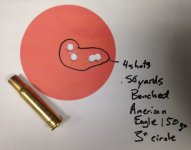Well, here's a couple ideas that might be worth a peek at:
Standing:
Take a of masking tape with you to mark your foot position- try several widths & angles.
Try placing your 'loop' fingers on the bottom of the loop to grip the whole wrist and loop. Maybe it's my stiffness & arthritis- but I can feel the difference on a Win 94 and the outside IS more comfortable.
There have been a number of skinners made over the years. Can you get the sight closer to your eye? Going to a smaller aperture would be great for the best of lighting conditions, but you'd likely develop a dislike for my recommendation in less than ideal lighting.
Go ahead and grab a shooting jacket like this:
http://www.militarylogisticsmfg.com/p0002252.html I don't know why they work, but they did seem to help my scores a bit.
Footwear... there was a recent thread on here about barefeet shooting or moccasins, or whatever. My favorite footwear has always been a pair of my old jump boots. Apparently squishy soles aren't everybody's favorites. Look at whatever you have that gives you the stablest platform.
With a bit of searching- you might locate a trigger shoe. Not sure if that would be up your alley or not- but they're out there.
Are you bringing your rifle as far up to your eye as possible, or are you bringing your head down to the sights more? Look at pics of match shooters. Any more, they barely keep any buttplate at all on their shoulders.
Breathing- Do you try to actuate the trigger on a full exhale or a 3/4 exhale? If you do one, try the other. I like the 3/4 better. And don't forget to breathe often. There's a term for what happens to your eyes when you don't breath and blink as often as you should (besides "dying"- definitely breathe enough to avoid that). Yeah, I said "actuate the trigger" I don't want someone to come along and beat me up because I didn't specify "press", "pull", "squeeze"- we all know it gets to the rear no matter what we call it.
Speaking of triggers- would any of your firearms benefit from action/trigger jobs? One at a time, they really aren't all that expensive when spread out.
From the Bench:
Are you placing your rest as close to the receiver as possible? That tends to help keep influence off barrels that aren't free-floated.
Try placing your left hand in different places to see if one will give you a more natural support of the rifles during the firing process.
Can you place your elbows on soft grippy surfaces like a piece of carpet or such?
Are thicker/thinner, harder/softer, grippier/smoother buttplates an option worth looking at?
Can you plant a 3 to 4 foot stick of rebar with a 12"-14" piece of engineer tape on it close to the target to use as a windflag to help read the wind? There used to be thing on the web called "Virtual Benchrest" that gave pretty good lessons on reading wind.
Anyway, these are just a few wonderments I have and hope one or two might work out for you. I guess the real secret would be to actually shoot with you to discuss firsthand what tips might be imparted- but that would be difficult I guess. Somebody else will be along shortly and I'm sure they will have some good points too. Hang in there, and good luck, and have fun.

